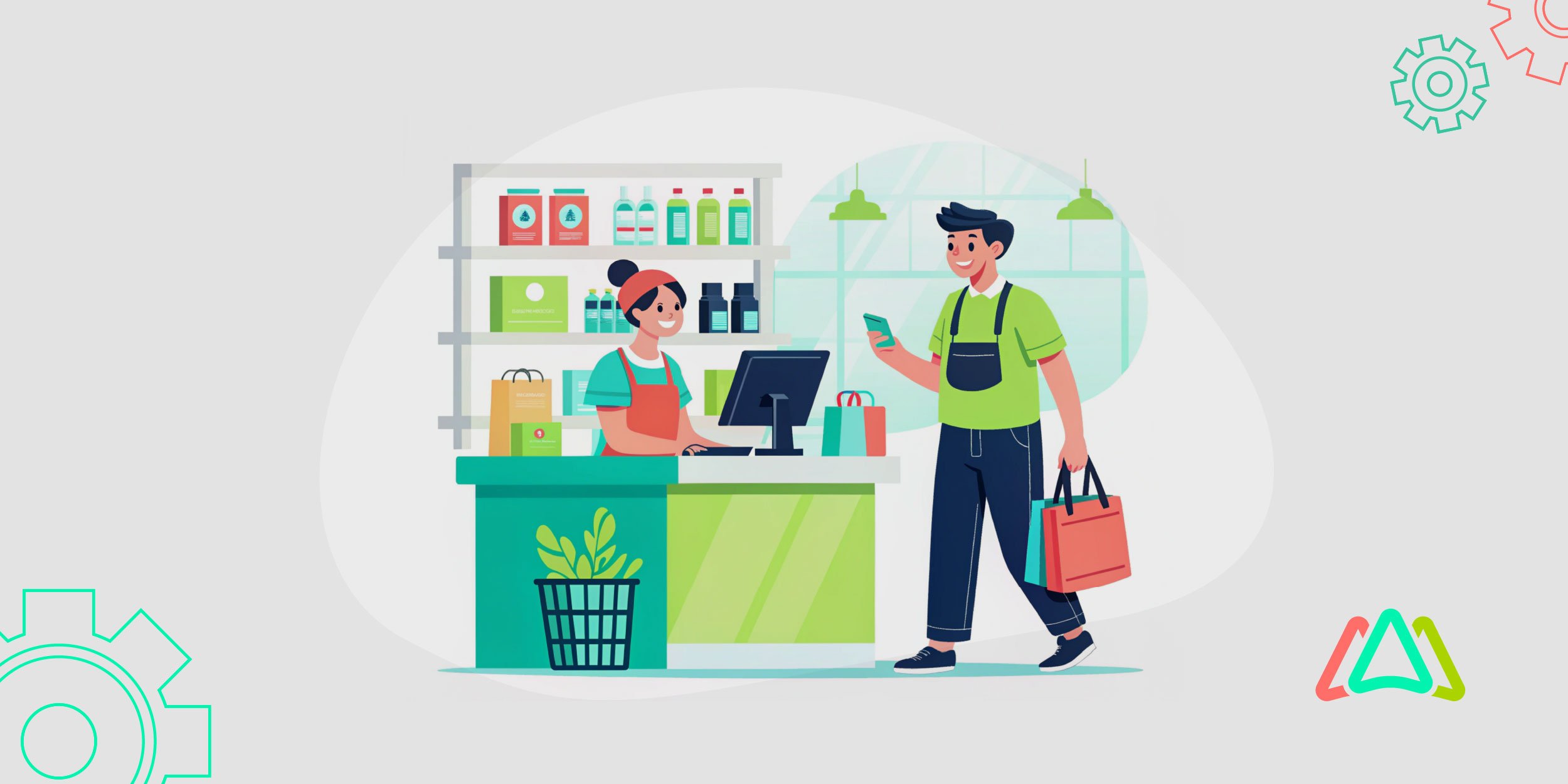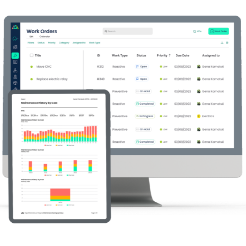
How CMMS Can be a Competitive Advantage in Customer-Facing (B2C) Businesses
B2C businesses, such as retail, hospitality, and food service, operate in a highly competitive environment where customer experience (CX) is paramount.
Customer experience (CX) refers to a customer's perception towards their interactions with a company, product, or service throughout their entire journey. It includes all touchpoints a customer has with the brand, from initial discovery to post-purchase support. Factors like ease of use, customer service, communication, and emotional connection influence customer experience. For this reason, brands invest heavily in marketing, store design, digital platforms, and staff training to ensure they stand out from the competition. Despite these areas of focus, operational reliability is often overlooked as a key driver of the customer experience. This is where a Computerized Maintenance Management System (CMMS) becomes essential—not just as a maintenance tool, but as a strategic component of CX and brand loyalty.
Historically, CMMS platforms have been seen as tools for tracking work orders, scheduling preventive maintenance, and managing assets. While these are still core functions, today, evolving B2C businesses are beginning to recognize that CMMS software also plays a direct role in delivering a smooth, consistent, and branded customer experience. From ensuring HVAC systems operate properly during peak seasons to preventing refrigeration failures in grocery chains, CMMS makes sure that the infrastructure supporting your customer experience performs flawlessly.

When asset performance declines, both customer perceptions and revenue suffer. Equipment downtime, malfunctioning restrooms, broken escalators, and poor facility conditions all impact how customers feel about a company’s brand. Since we live during a time when experience defines loyalty, it makes sense to leverage a CMMS to its fullest to maintain asset uptime and service consistency. When done, a CMMS provides B2C businesses a decisive competitive advantage.
In this article, we’ll explore how CMMS contributes to CX by improving consistency, predicting problems before they become visible, and scaling brand standards across multiple locations—all while reinforcing brand trust and loyalty.
The Link Between Maintenance and Customer Experience
In customer-facing (B2C) industries, the quality of the physical environment is inextricably linked to the overall customer experience. A hotel room with a burnt-out light bulb, a retail store with under-performing air conditioning, or a restaurant with a malfunctioning restroom are all problems rooted in facility or equipment maintenance. Although they can be an annoyance to customers, they can also have a direct impact on how they perceive the brand. These seemingly minor disruptions do not go unnoticed and, as a result, they can erode trust and diminish brand credibility, especially in businesses where the customer experience is central to repeat business and word-of-mouth marketing.
A CMMS plays a vital role in preventing these negative impressions. By automating maintenance schedules, tracking asset health, and facilitating rapid response to service issues, CMMS ensures that everything behind the scenes runs smoothly so the front-end experience feels effortless and consistent. By meeting this challenge, a CMMS becomes an invisible but essential layer of the customer experience. The software plays a crucial role in ensuring that every visit, stay, or purchase meets the standards customers expect, thus reinforcing brand value and fostering loyalty.
CMMS as a Brand Equity and Loyalty Tool
Consistency is one of the most potent contributors to brand equity in the B2C marketplace. Simply put, customers return to businesses that deliver a reliable and predictable experience. Having a spotless hotel room, a fully stocked grocery aisle, or a smooth check-in at a movie theater kiosk are the experiences that keep people coming back and referring others to do the same.
In industries with multiple locations or franchises, maintaining consistency across all sites can be a significant challenge. A CMMS enables companies to implement standardized maintenance protocols, track performance across locations, and ensure brand promises are fulfilled regardless of venue location. This is especially critical in franchises, where one poorly maintained location can damage the entire brand’s reputation.
Moreover, a retail CMMS helps reinforce customer loyalty by minimizing disruptions and enhancing the perception of quality. Preventive maintenance schedules and real-time asset monitoring reduce the likelihood of visible breakdowns or service outages, enabling businesses to meet customer expectations consistently. When customers associate a brand with reliability, it’s a CMMS that can protect both assets and customer relationships.
Proactive Insights: Spotting Issues Before Customers Do
One of the most strategic advantages of a CMMS is its ability to turn maintenance data into actionable insights. By tracking work order history, failure rates, asset lifecycles, and technician responses, a CMMS can help identify recurring issues, high-failure assets, and operational hotspots—long before these problems become visible to customers. For example, if a specific HVAC unit in a hotel frequently fails during peak summer months, the system can flag this trend, prompting preemptive servicing before guests are inconvenienced.
This type of proactive maintenance has a direct impact on customer satisfaction. Rather than waiting for a breakdown to affect service or experience, businesses can address an identified problem early and still maintain an uninterrupted service. It also enables teams to transition from reactive firefighting to strategic planning, creating a more controlled and predictable service environment that fosters customer confidence and trust. Ultimately, the ability to anticipate and resolve issues before they’re noticed reinforces the brand’s reputation for reliability and care.
Reducing Service Interruptions that Deter Repeat Business
In B2C industries, brief service interruptions can have significant consequences. For example, a broken escalator in a busy department store not only disrupts the customer experience but also signals the store’s lack of foresight into what should be a prioritized maintenance issue. Other examples are a swimming pool that is out of use due to a broken pump, or gym equipment that is unavailable in a fitness club. In today’s review-driven marketplace, a single negative experience such as this one often translates into poor online ratings that can ripple across the marketplace.
A CMMS helps mitigate these risks by enabling faster response times and better coordination between maintenance teams. Automated alerts, prioritized work orders, mobile technician access, and integrated parts inventory ensure that critical repairs happen swiftly and efficiently. By minimizing downtime and resolving issues before they escalate, businesses can maintain uninterrupted service—an essential factor in shaping positive customer perceptions and encouraging repeat visits.
CMMS + CX Strategy: A Competitive Differentiator
While many companies still view maintenance as a back-end function, forward-thinking brands recognize its strategic role in customer experience (CX). Experience-driven B2C companies must prioritize differentiators such as clean, well-maintained facilities and uninterrupted service, as these factors often matter more to customers than price alone. A CMMS supports this by aligning maintenance operations with CX objectives, ensuring that the physical environment reinforces the brand promise. For example, a hotel chain that promotes “comfort and convenience” can’t afford repeated HVAC failures or slow response times to room repairs. With a CMMS in place, maintenance becomes a consistent tool for delivering on that brand promise.
Businesses that successfully integrate CMMS into their CX strategy can acquire a significant edge over their competitors. CMMS’s proactive approach toward maintenance enhances service reliability, builds customer trust, and contributes to a positive brand narrative. In contrast, companies that fail to make this connection risk allowing minor, preventable issues to tarnish their customer relationships. With growing numbers of businesses competing on experience, rather than just product or price, the ability to deliver seamless, reliable service through smart maintenance becomes a key differentiator.
Building a Feedback Loop with Maintenance Data
To truly leverage CMMS as part of a customer experience strategy, businesses must connect operational data with customer feedback to gain a comprehensive understanding of their customers' needs. Many service disruptions leave a trail of clues—not only in maintenance logs, but also in customer complaints, online reviews, and satisfaction scores. By integrating CMMS data with systems like CRM or customer service platforms, businesses can create a feedback loop that identifies how asset performance impacts customer sentiment. The connections that emerge can point maintenance managers in the direction where their attention is needed the most.
This feedback loop transforms maintenance from a reactive cost center into a responsive, customer-focused function. Teams can prioritize issues that most affect customer satisfaction, adjust preventive maintenance schedules based on real-world outcomes, and even train staff based on recurring issues tied to negative experiences. With this approach, maintenance decisions are informed by what customers truly value. Over time, it will enhance operational efficiency and deliver a superior customer experience.
Some CMMS software platforms offer easy ways for customers to notify businesses of maintenance issues. Click Maint, for example, has a request portal where customers can use their camera on their phone to scan a QR code and quickly submit a maintenance request when they notice something is not working in the facility. Customers can also get email notifications on the status of the request and updates on when the issue has been resolved. This streamlines the process, speeds up the resolution time for maintenance issues, and ensures customers are up to date on the progress.

Scaling and Standardizing Across Multiple Locations
For franchises, retail and hotel chains, maintaining brand consistency across dozens—or even hundreds of locations is a significant challenge. As previously noted, a CMMS provides the structure and visibility needed to implement standardized maintenance procedures at scale. Centralized scheduling, asset tracking, and performance reporting enable corporate teams to ensure that every location adheres to the same operational standards and best practices. Whether it’s ensuring every store opens with fully functioning equipment or every hotel room is inspected to the same quality benchmark, CMMS helps enforce uniformity in execution at all locations.

This consistency reinforces the brand promise, giving customers confidence that, regardless of which location they visit, they’ll receive the same level of service and quality. Moreover, a centralized CMMS enables benchmarking across sites, helping identify top-performing locations, uncover systemic issues, and replicate best practices enterprise-wide. In a competitive B2C landscape, the ability to scale reliability and quality becomes a critical driver of loyalty and operational excellence.
Conclusion
In customer-facing industries, where every interaction contributes to shaping the brand perception, the reliability of assets and facilities plays a crucial role in defining the customer experience. A CMMS is no longer just a tool for maintenance teams; it's a strategic asset that supports brand consistency, minimizes service disruptions, and enables proactive improvements based on real data. When implemented strategically, CMMS empowers businesses to not only protect their physical assets but also actively enhance customer satisfaction and loyalty.
As customer expectations continue to rise, companies that treat maintenance as part of their CX strategy will gain a clear advantage over those that don't. By investing in a CMMS and integrating it into the broader business strategy, organizations can ensure their environments reflect the reliability, professionalism, and care that customers expect, making every visit not just satisfactory, but memorable.
TABLE OF CONTENTS
Keep Reading
Spare parts management within maintenance can make the difference between a problem-free ...
16 Dec 2025
Every maintenance team eventually faces the same question: When should we repair, and when ...
12 Dec 2025
Enterprise Asset Management (EAM) software has become a cornerstone for organizations aiming ...
12 Dec 2025
Unexpected equipment breakdowns can disrupt operations, increase repair costs, and reduce ...
11 Dec 2025
Businesses are always looking for ways to improve efficiencies, reduce costs, and improve ...
9 Dec 2025
The longest U.S. federal government shutdown to date lasted 43 days, beginning on October 1, ...
5 Dec 2025
Every maintenance professional faces it sooner or later — that critical time when an aging ...
18 Nov 2025
The term 'best' is often used loosely, without a clear understanding of its context or ...
14 Nov 2025
In the not too distant past, maintenance strategies have been defined by reaction—fixing ...
13 Nov 2025
Tax season is the time of year that often sends a ripple of anxiety through many of us. The ...
11 Nov 2025
Selecting a Computerized Maintenance Management System (CMMS) can, at first glance, be an ...
4 Nov 2025
In healthcare facilities, equipment uptime involves more than achieving operational ...
31 Oct 2025
Companies are subject to economic ups and downs, also known as economic volatility. Today, ...
30 Oct 2025
Maintenance challenges are a constant struggle, with unplanned downtime costing manufacturers ...
27 Oct 2025
Last winter, a maintenance technician at a U.S. paper mill ignored a predictive alert that ...
10 Oct 2025
Many organizations proudly say they “have a CMMS,” but ownership alone doesn’t equal ...
9 Oct 2025
Every maintenance team is under pressure to do more with less. Unplanned downtime is often ...
7 Oct 2025
The implementation of simple, yet powerfully effective, checklists has repeatedly ...
3 Oct 2025
In manufacturing, every second counts. When production stops, whether due to scheduled ...
2 Oct 2025
The increasing cost of maintenance, lack of accountability, and siloed systems leave many ...
30 Sep 2025






